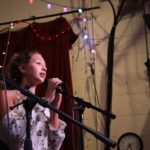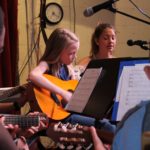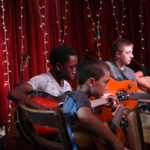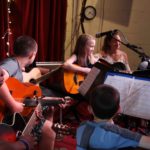 About the Author
About the Author
Marc-Andre Seguin is the webmaster, “brains behind” and teacher on JazzGuitarLessons.net, the #1 online resource for learning how to play jazz guitar. He draws from his experience both as a professional jazz guitarist and professional jazz teacher to help thousands of people from all around the world learn the craft of jazz guitar. Marc-Andre was kind enough to reach out and create a custom blog post for our students at Guitar Shed. I mentioned to him that one of the main things our students are struggling with is being able to keep the form of a song. Read on for some very insightful tips and advice. Thanks Marc-Andre!
Tips to Learning Chord Progressions
Learning a new song song, especially the sequence of chords, can be a long and daunting task. Here are a few tips to help you memorize the order of chords in any song you wish to play. Although the first suggestion is quite simple, the rest of the article is really something you should take your time with. If you manage to incorporate this into your musical understanding, you will reap the benefits in the long term and have an easier time understanding music in general.
Break the song up into sections
If you take the time to divide the song into sections and then smaller chunks if needed, you’ll have a much easier time remembering the music as a whole. For example, take the time to identify the choruses as opposed to verses. Usually, these will have different progressions and will have lengths of 4 or 8 bars. It will make things a lot less daunting and easier to chew on. Some songs have also bridges to consider.
When starting out, it’s a good idea to actually write the chords out on a piece of paper. Draw out a grid with 4 bars per line (I simply draw 5 vertical lines with even space between them to make up the 4 bars). Then, making sure you count the beats, write in the chords. For every beat that repeats the same harmony, write a single slash to keep track of the harmonic rhythm, which is simply a nice way of saying when the chords change. Keep track of each section and label them when needed. Once you’ve written out the whole song, seeing the music in parts like this will help you memorize the music by breaking it down to smaller, more manageable pieces. Here is a short example to illustrate a simple chart:
Verse
| G / / / | C / / / | G / / / | D / / / |
Chorus
| G / / / | / / / / | D / / / | / / / / |
At this point, if you are a beginner or simply having trouble committing songs to memory, it’s a matter of memorizing the chords, by name, until you can play each section by heart. It’s a tedious process, but it’s part of the bigger picture which will enable you to see patterns and accelerate the learning process.
Calling the chords by roman numerals, rather than by name
Eventually, once you’ve spent enough time simply learning songs chord by chord, it’ll be time to enhance you’re theoretical knowledge to eventually help you learn faster and even transpose music quickly.
The first thing that you’ll need to be capable of doing, is identifying the key of a song. A fast and almost foolproof way of doing this is checking out the last chord of the piece. To be sure though, the simplest way at this point is to first write down all the unique chords present in the piece of music you are looking at. Then, starting from the root of each of those chords, write down the corresponding major or minor scale that start from that note. If you have a 7th chord in a piece that’s not a blues song, chances are that the key won’t be from that scale, so you can skip those. Once you’ve written out all the notes, compare each and every note in the scales you wrote down with the roots of the other chords in your song. If something is out of place (for example you might have a Bb chord in your list when you write out the C major scale – that scale doesn’t include B flats) go to the next chord until you find the perfect scale that fits the roots of all the chords.
Once you’ve determined the scale you are in, you will now be able to attribute roman numerals to the chords and effectively perform musical analysis to explain the music you have. Simply attribute the numerals to each chord in the progression relative to their position in the scale. For example, if you determine that the song is in C major and you see an F chord, that F would be IV (being the fourth note in C major). Repeat this procedure for the rest of the chords. If you wrote out the song in sections like mentioned previously, you can focus on sections and learn the progression in smaller chunks. You might end up with something looking like this for a particular section (with the respective harmony of your music):
| I / / / | VIm / / / | IV / / / | V / / / |
Eventually, this type of analysis will be made in your head and will come very quickly, especially if you do it often. On the guitar, it’s easy to then perform these sequences if you play with bar chords, streamlining the learning process to simply remembering the changes as jumps corresponding to the scale tones rather than a sequence of seemingly open random chords.
Another advantage of this type of analysis and playing is that once you become faster at recognizing the harmony changes as numerals, transposing music will be much simpler. By simply applying the numerals to the new key, it will be easier to call upon the correct chord this way than transposing each and every chord in the progression.
Recognizing common progressions
The more you apply roman numerals to chords, the more you will start to see recurring formulas. Although music itself is limitless, the progressions aren’t and our ears seem to gravitate towards a handful of sequences, preferences that are usually explained with theoretical concepts. You probably have come across a very famous progression called the blues. This relatively simple progression spans 12 bars and visits the IVth and Vth chords of a scale and inspired countless of songs, melodies and solos. Here it is in it’s simplest form:
| I7 / / / | / / / / | / / / / | / / / / | | IV7 / / / | / / / / | I7 / / / | / / / / | | V7 / / / | / / / / | I7 / / / | / / / / |
You should be able to play this at any key and visualize each change before it happens. This kind of rigorous learning will cross over to other progressions and make your life learning things a lot easier. Here are a few other common progressions you should be aware of:
– | I / / / | IV / / / | V / / / | I / / / |
– | I / / / | IIm / / / | V / / / | I / / / |
– | IIIm / / / | VIm / / / | IIm / / / | V / / / |
Although there are a lot of things to learn, you should definitely invest time in teaching yourself to identify song keys quickly and break down the chord progressions into numerical grids. You’ll be surprised how fast your understanding and ear training will develop and help you anticipate harmonic movement.

















